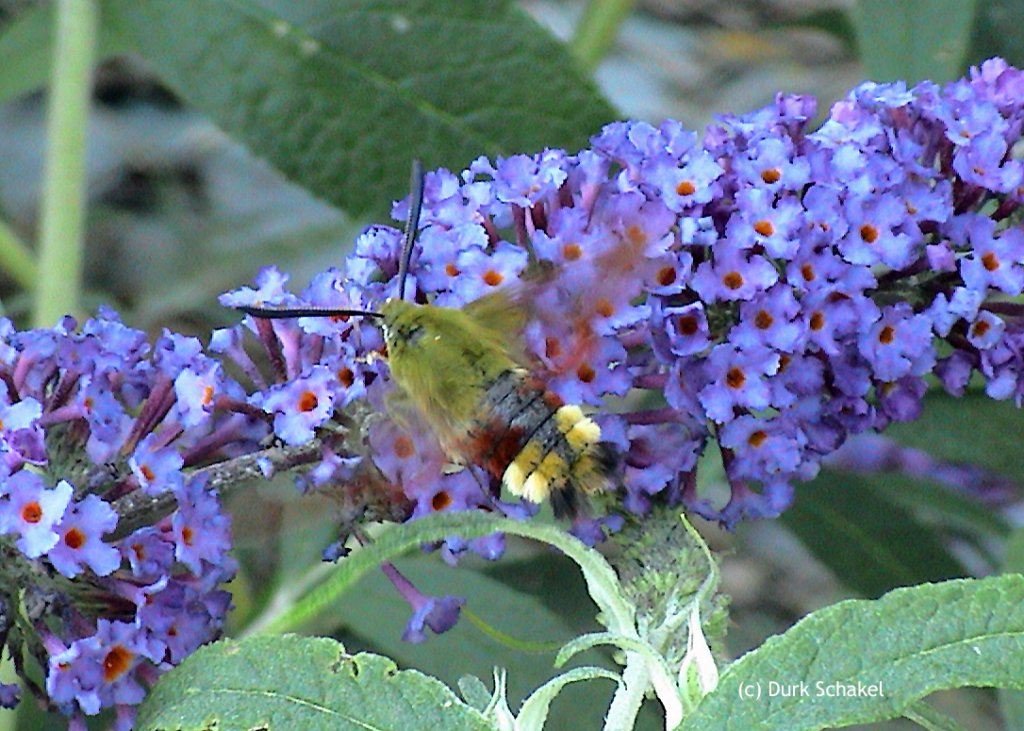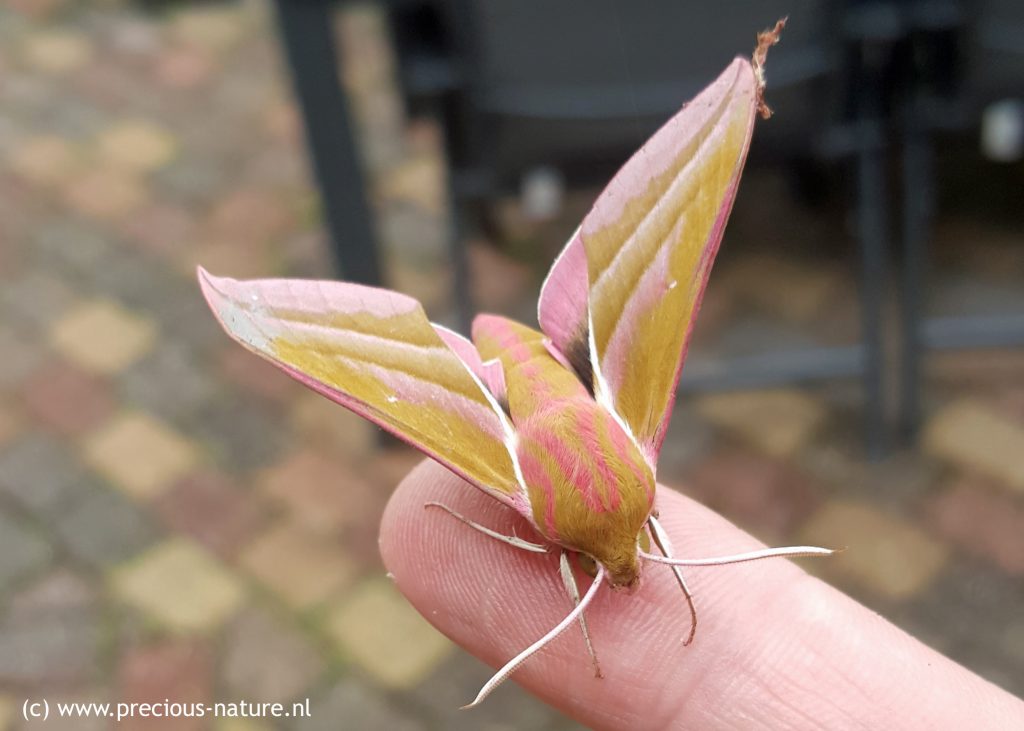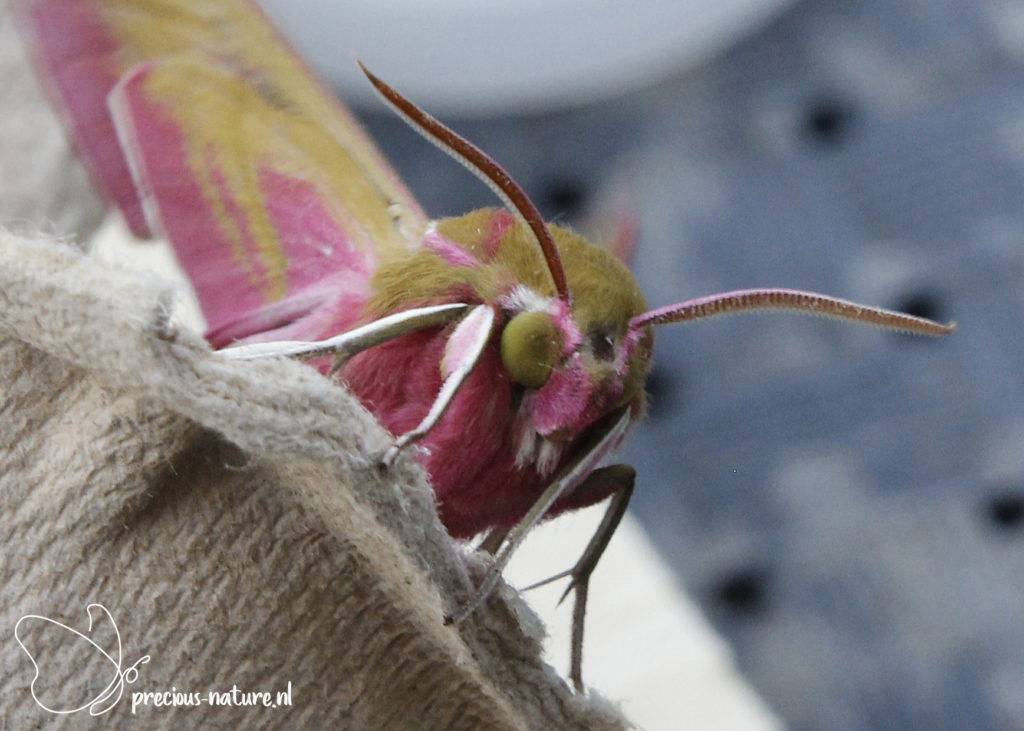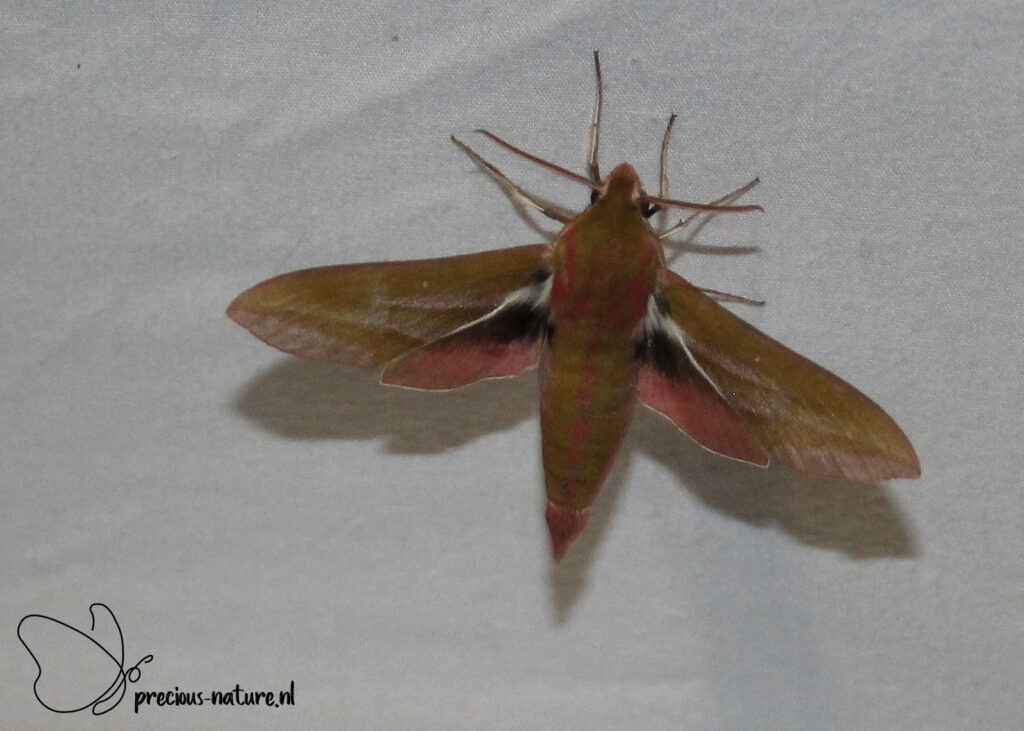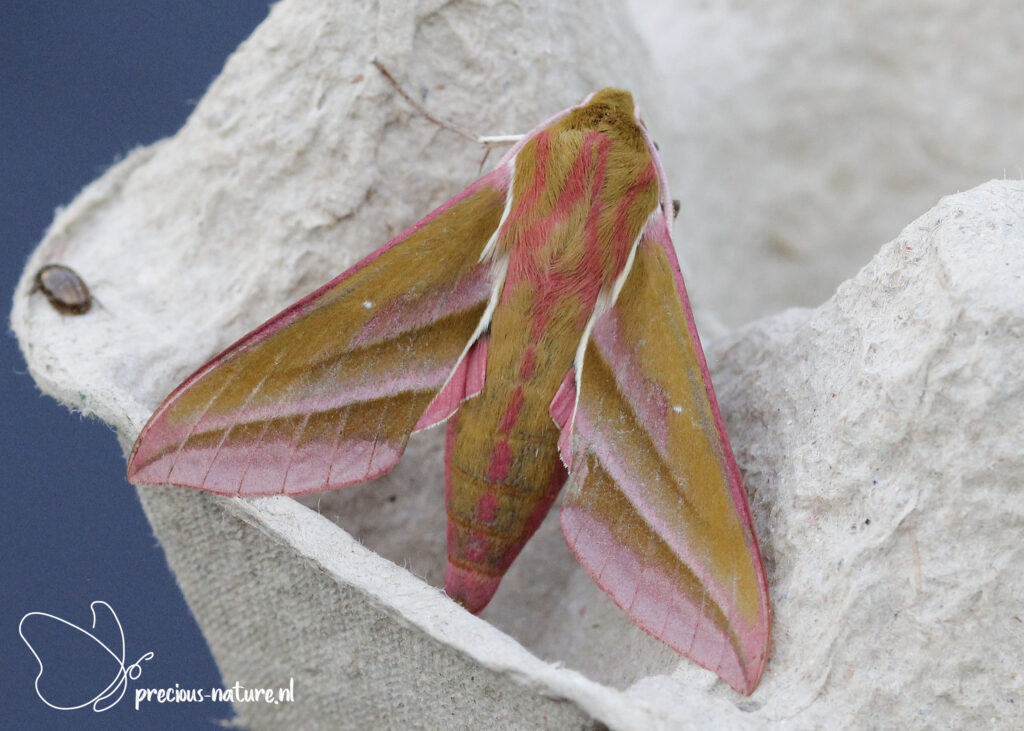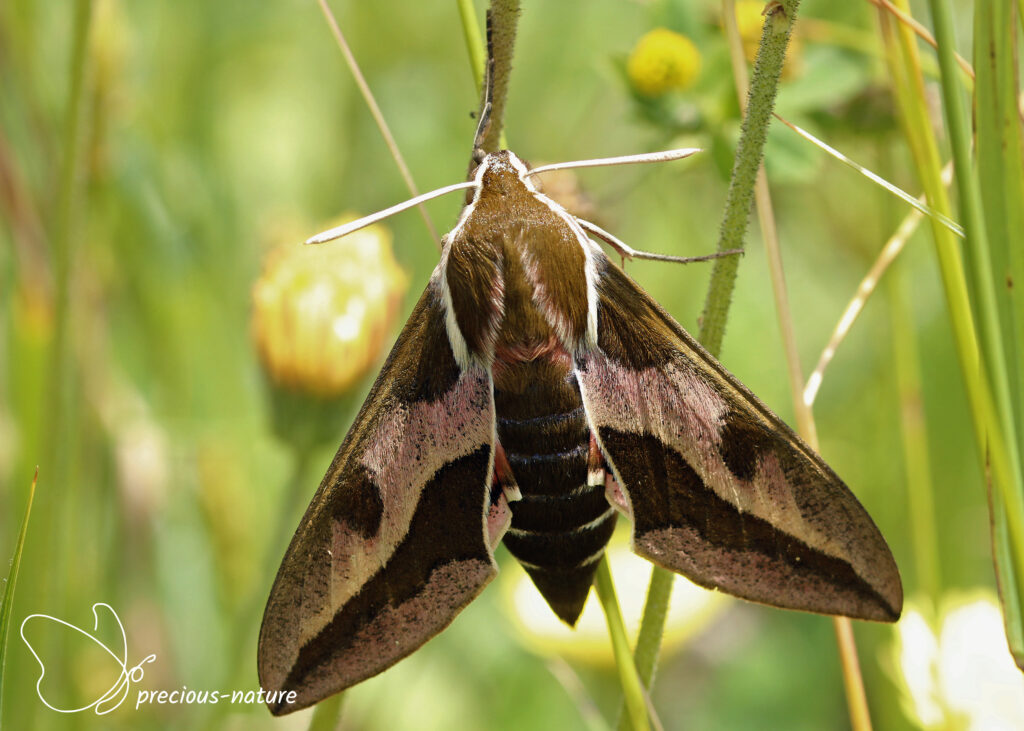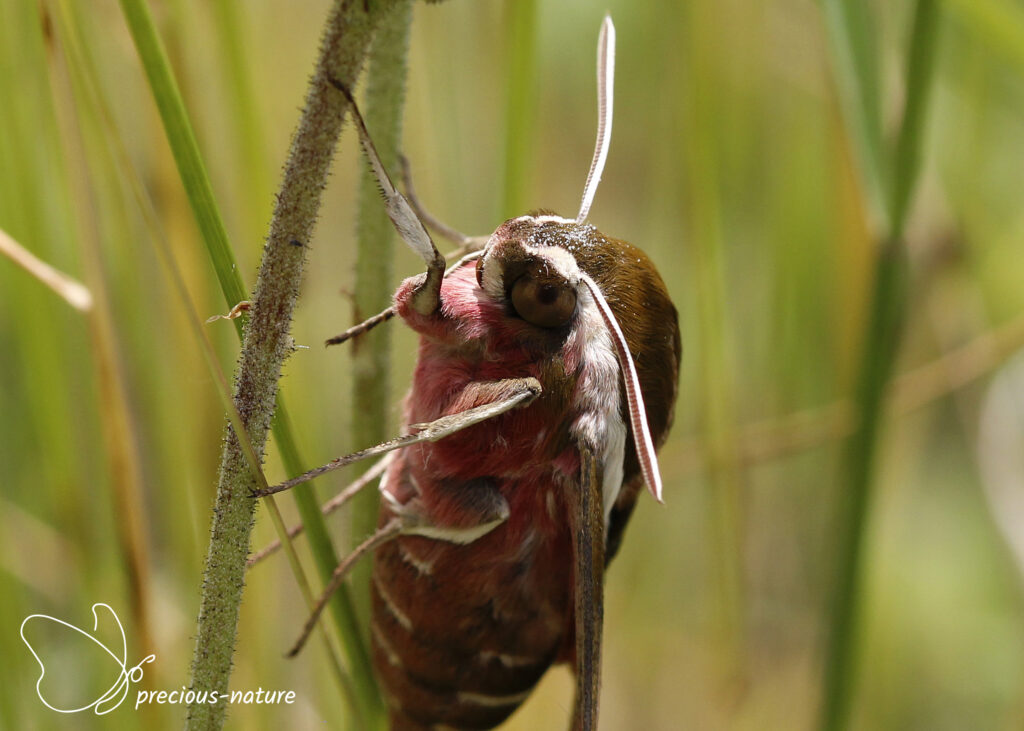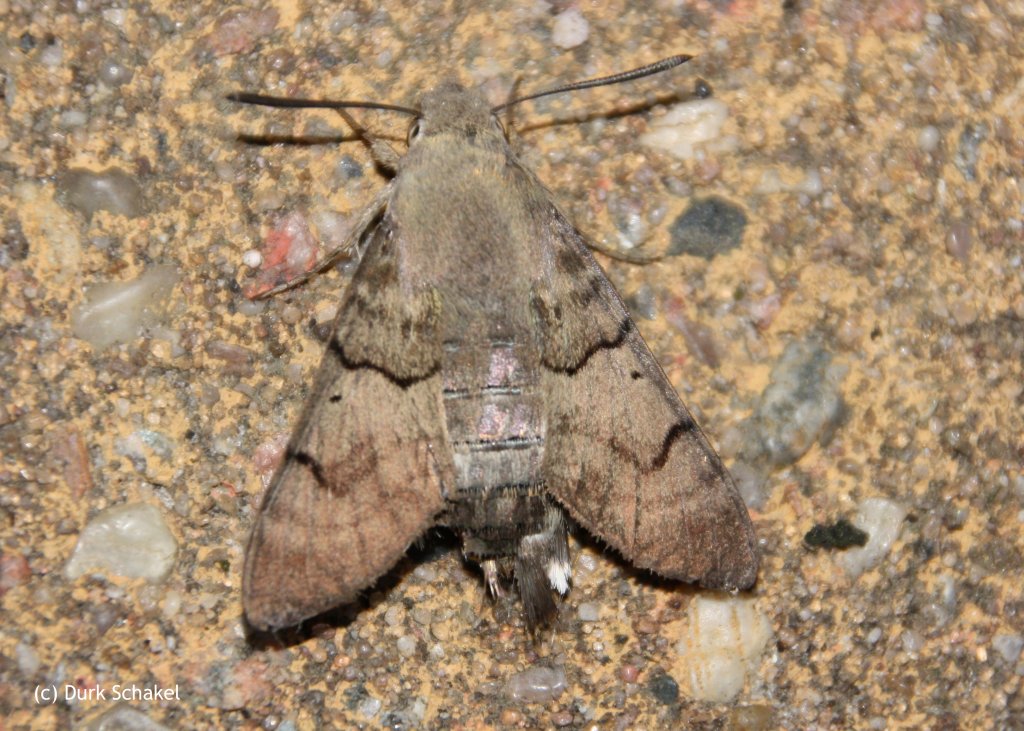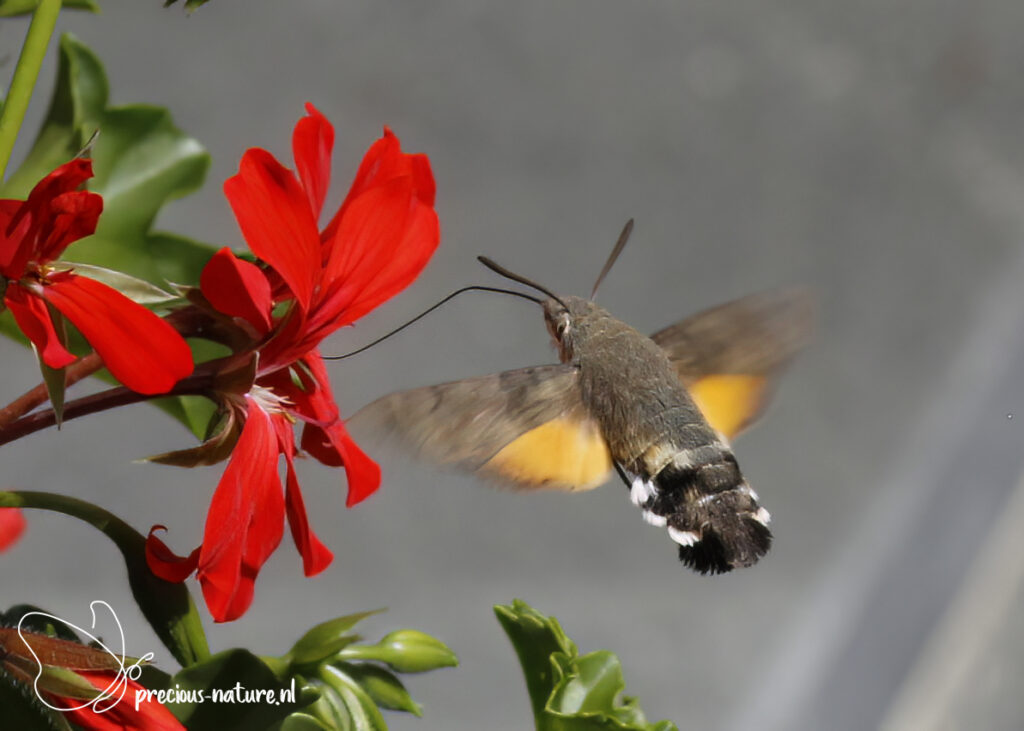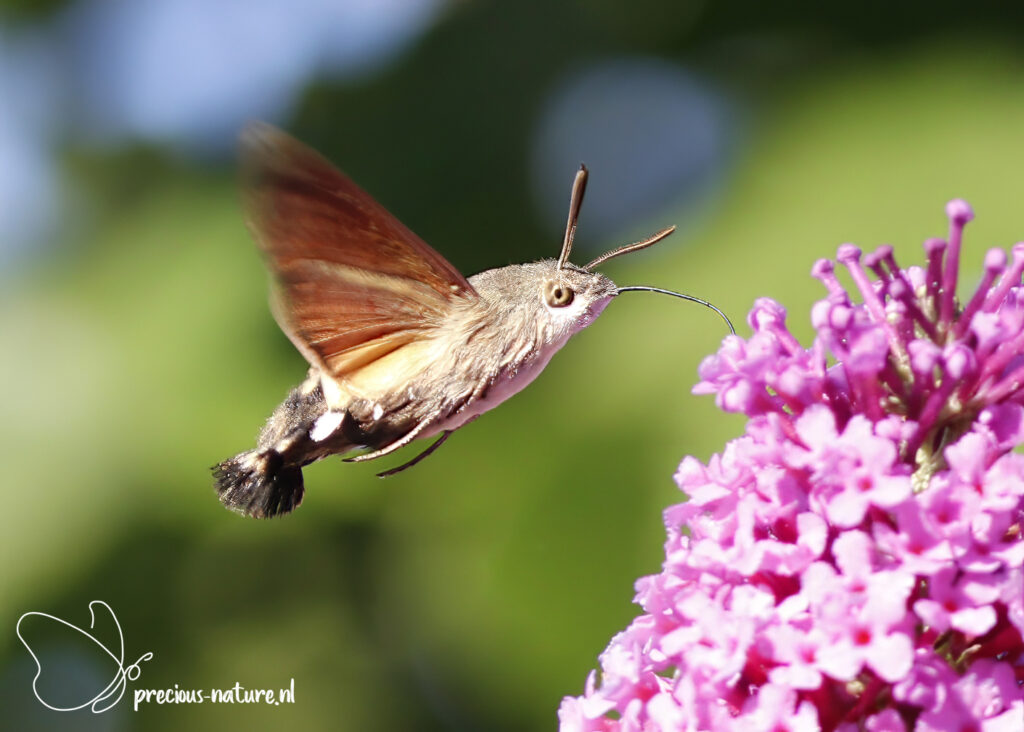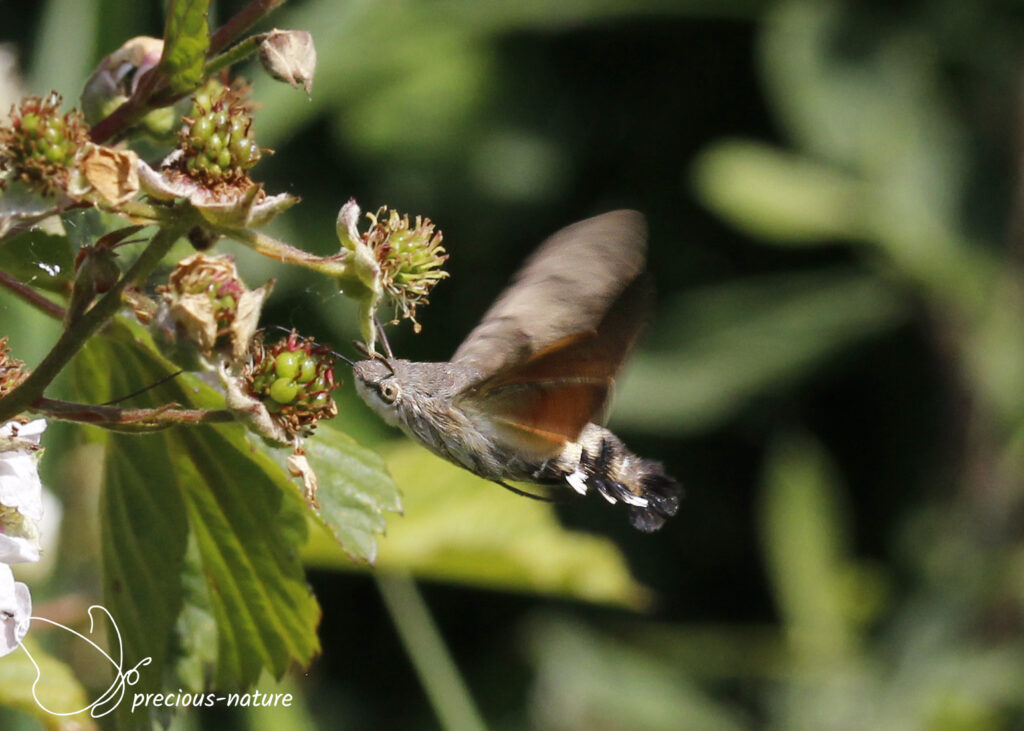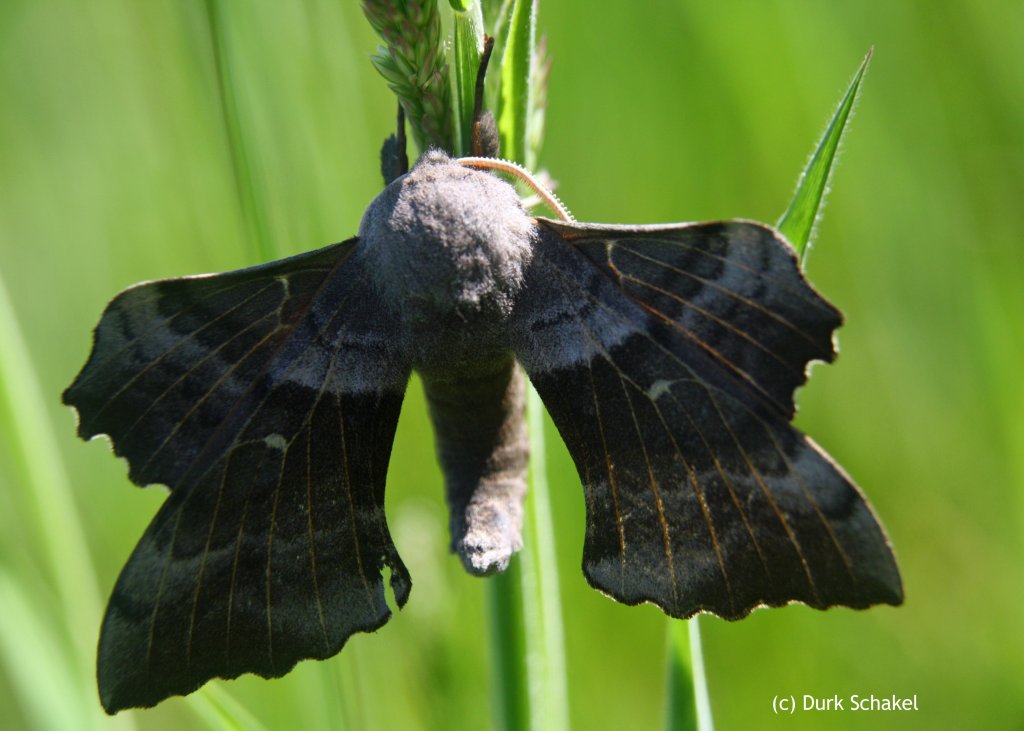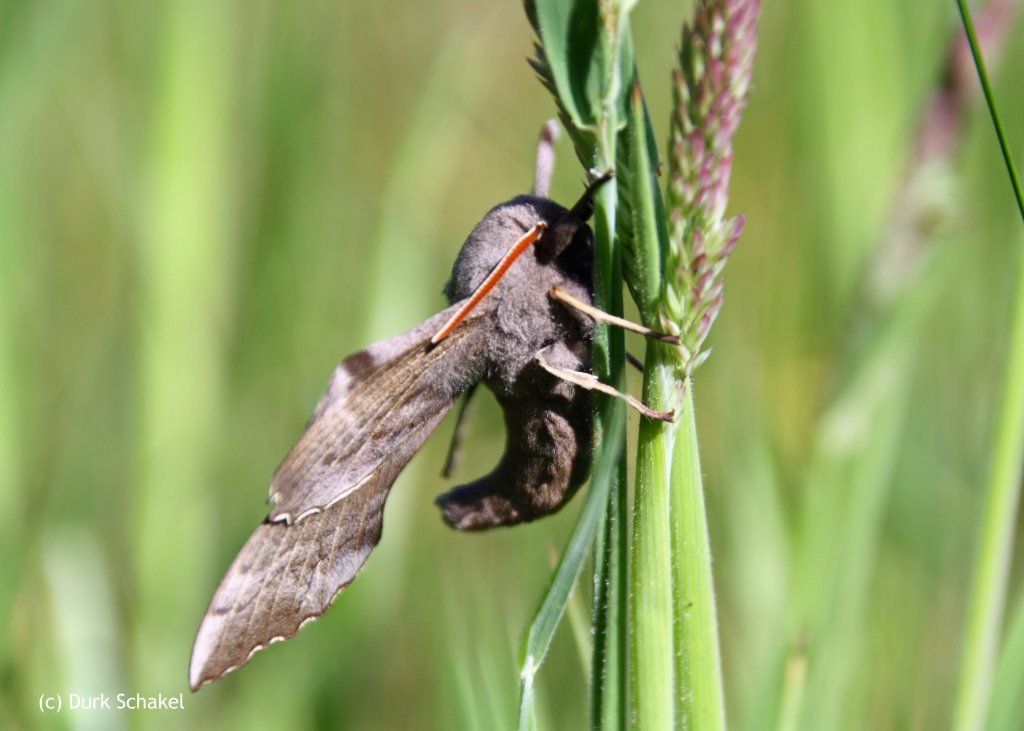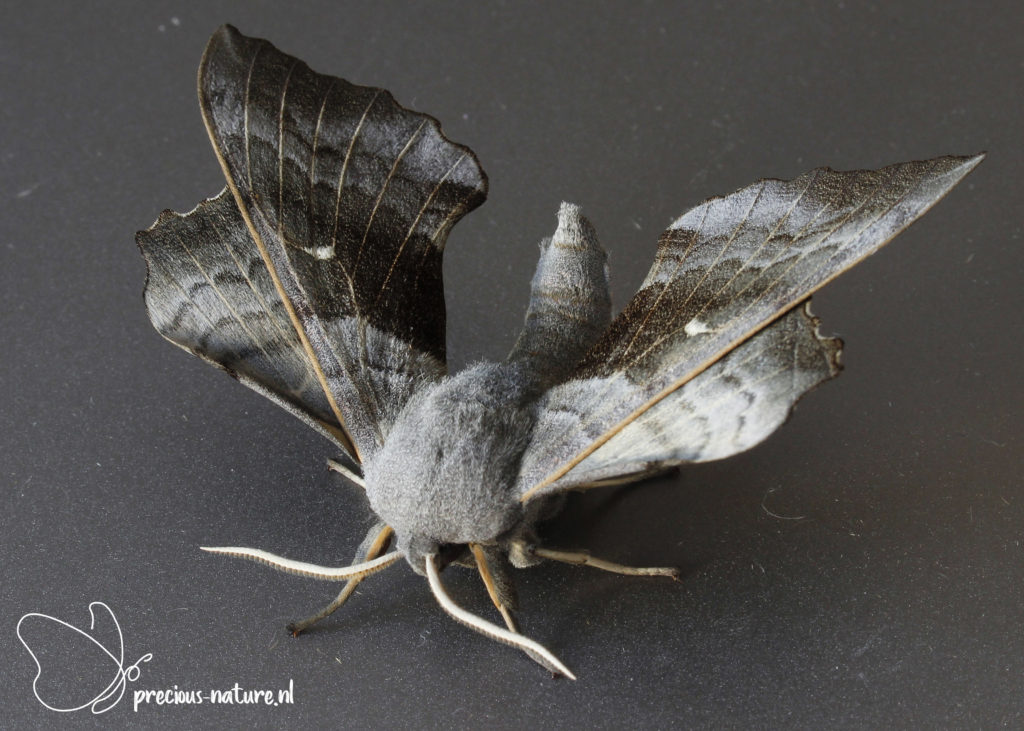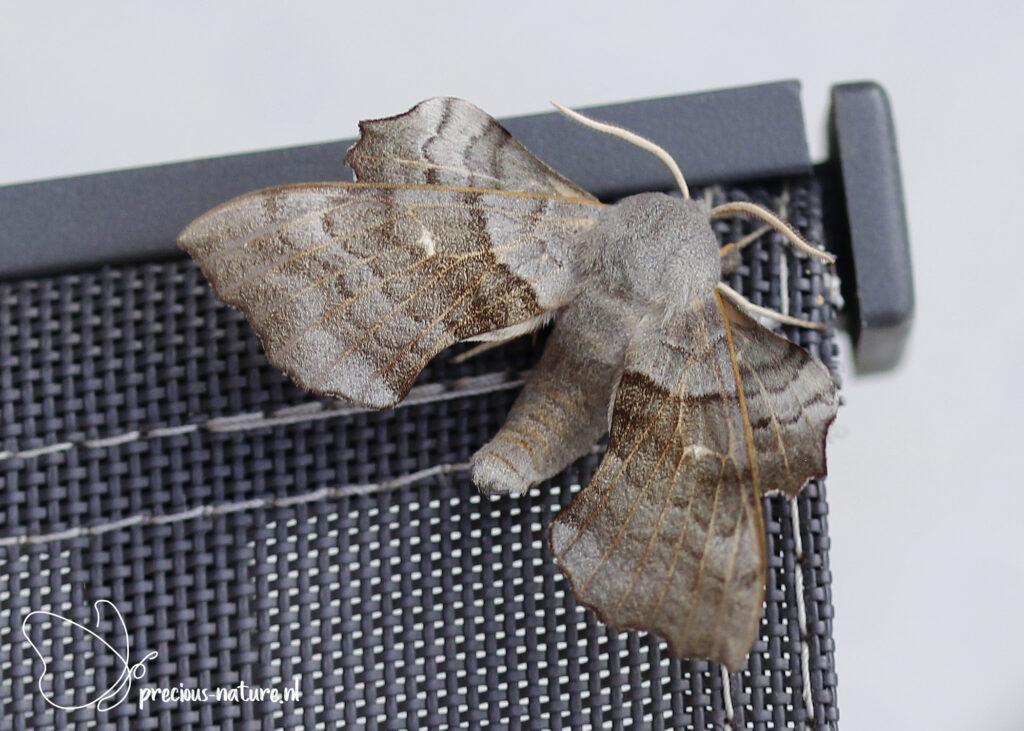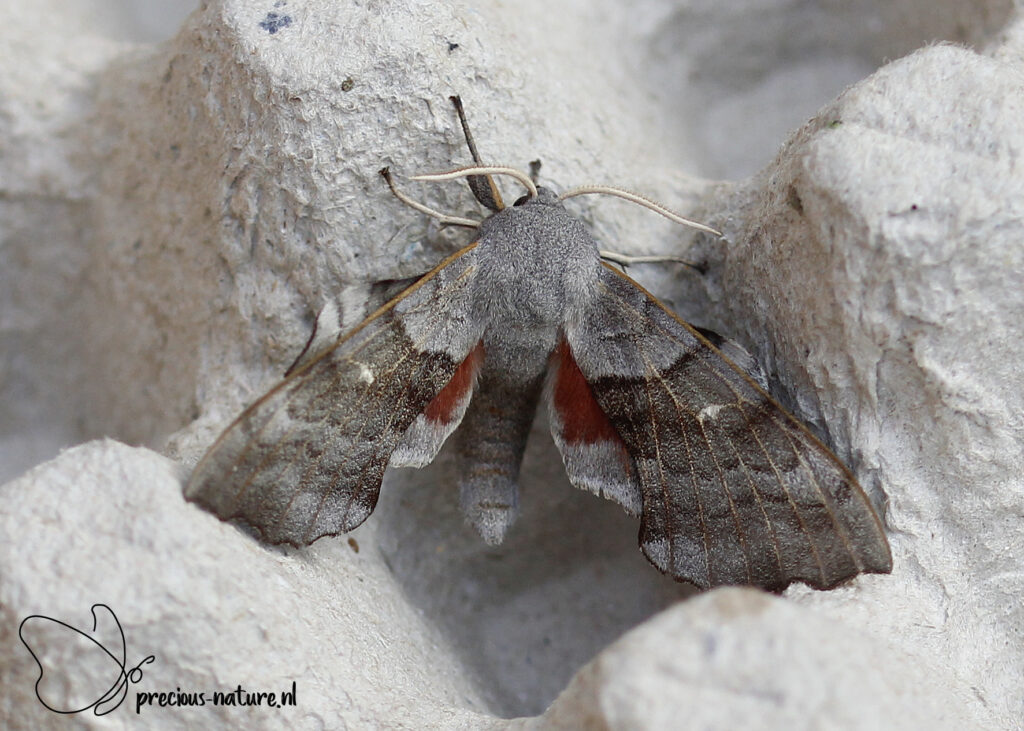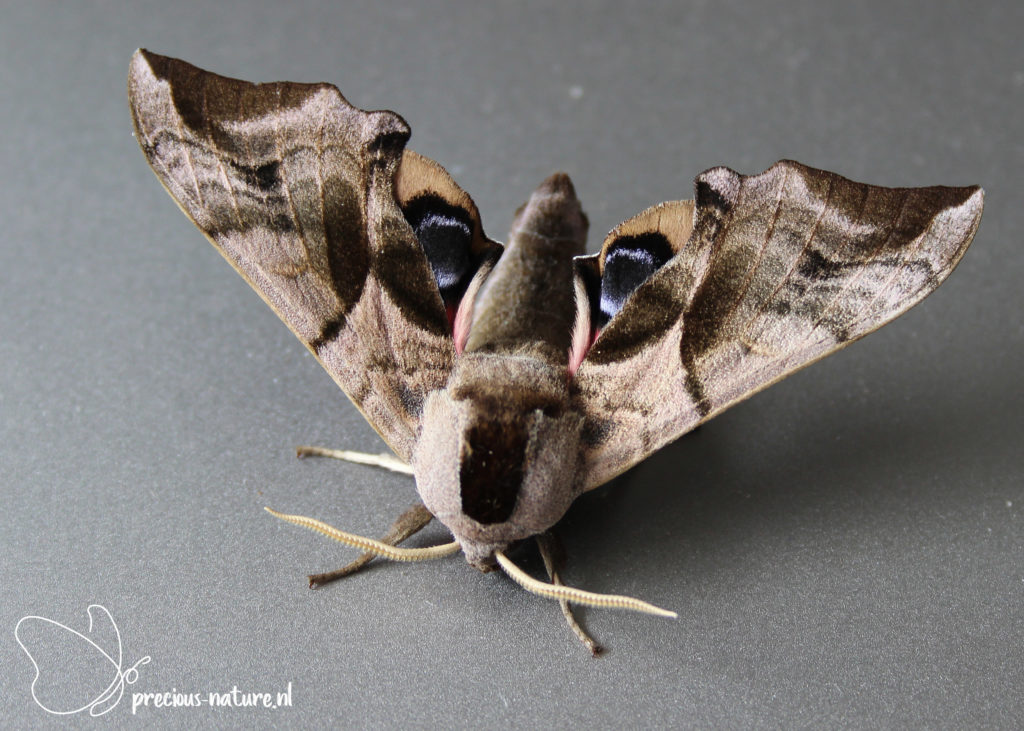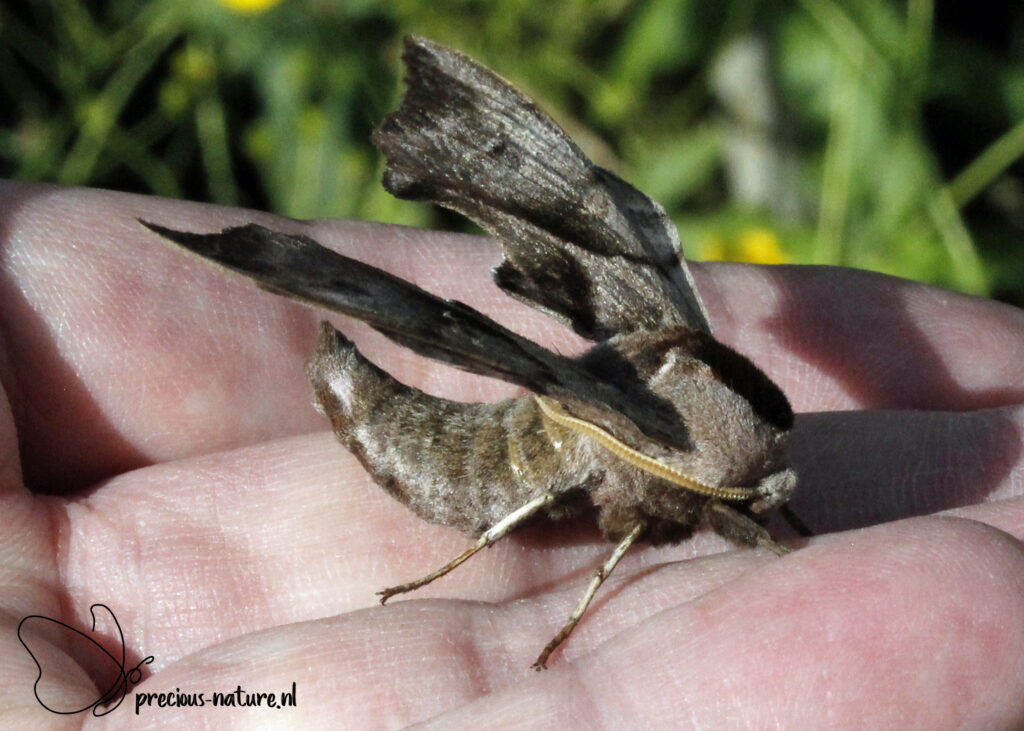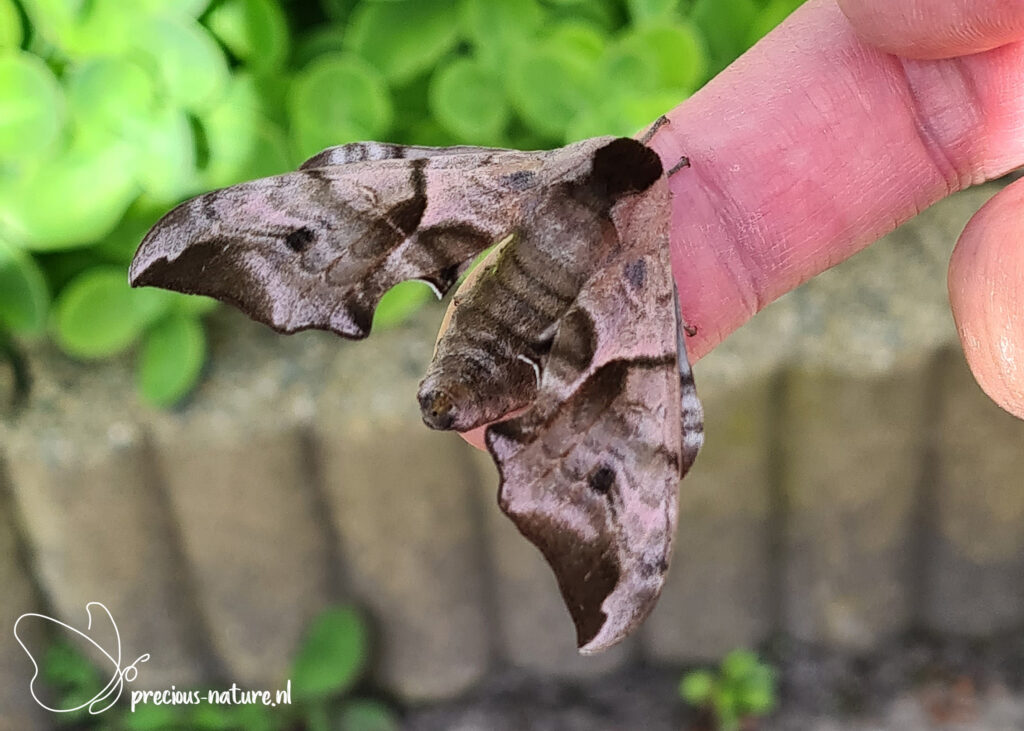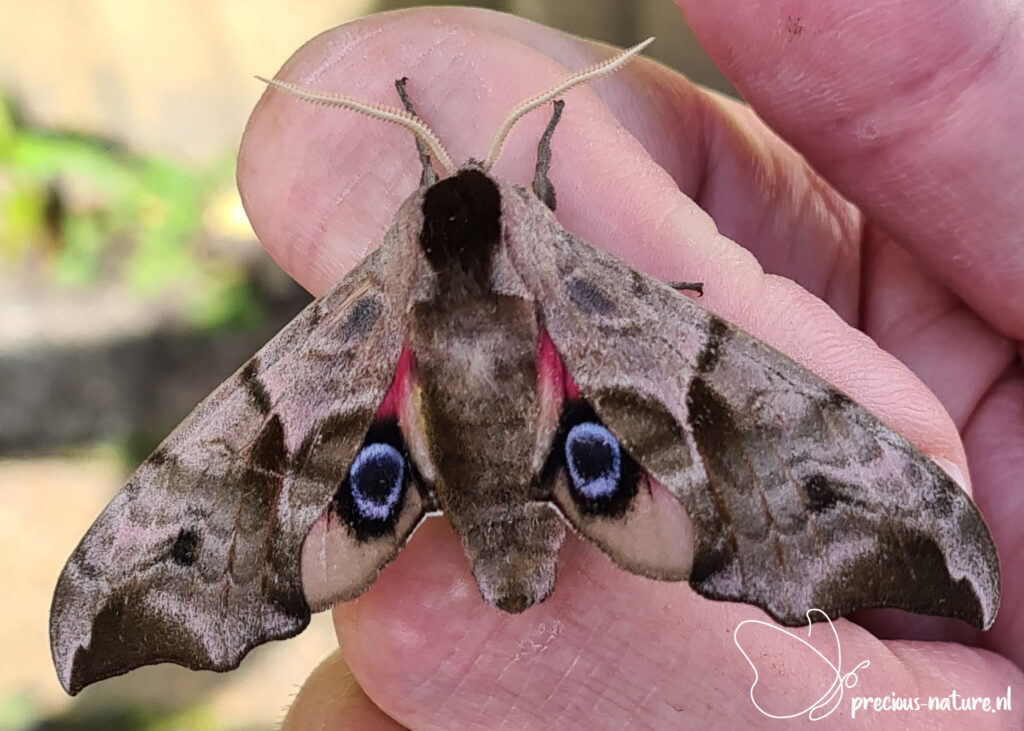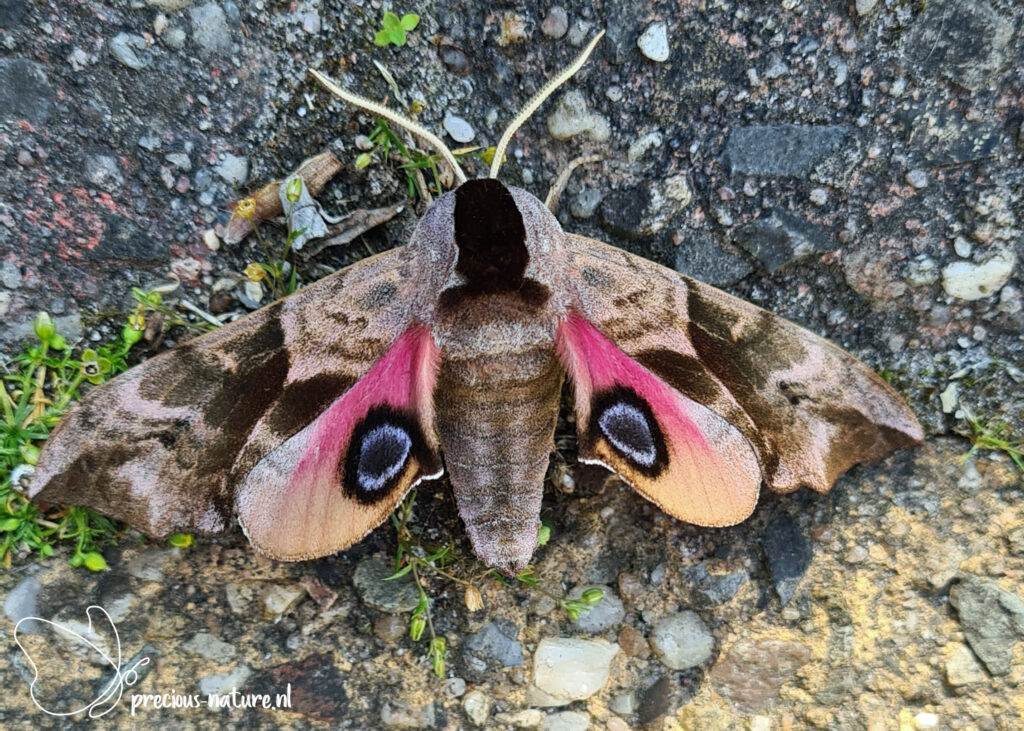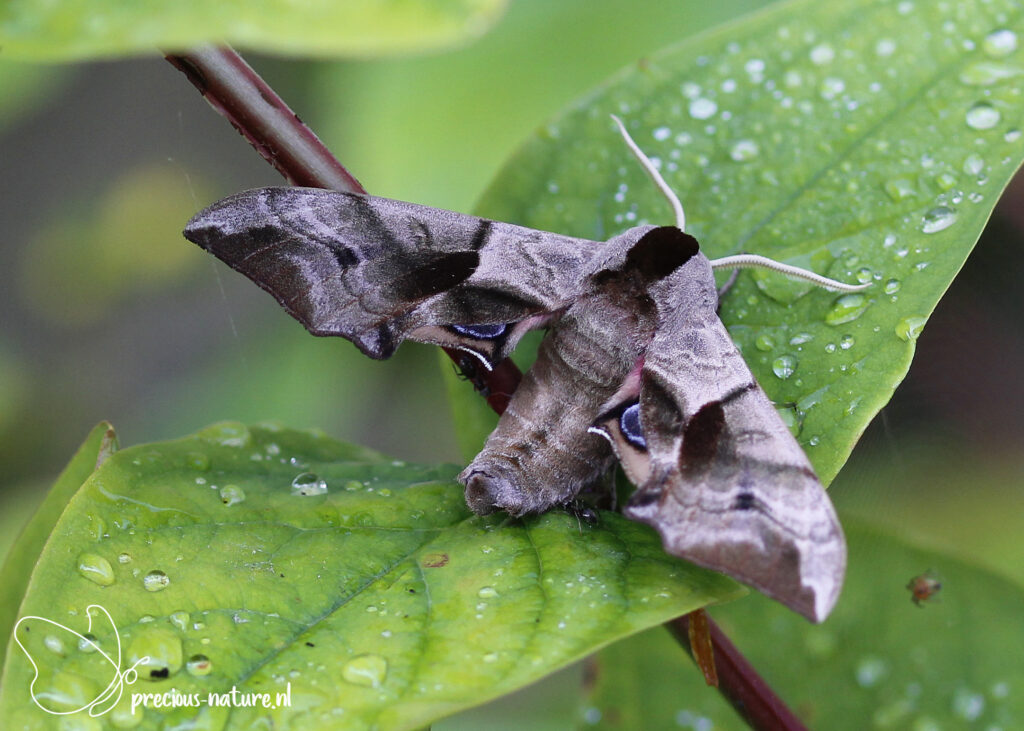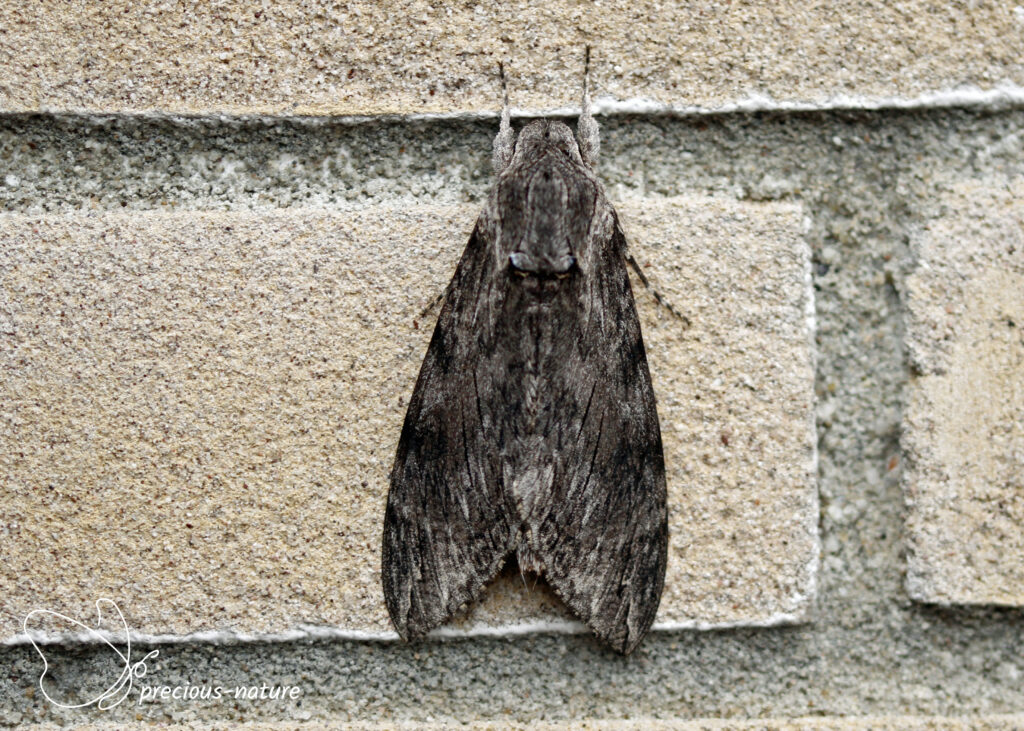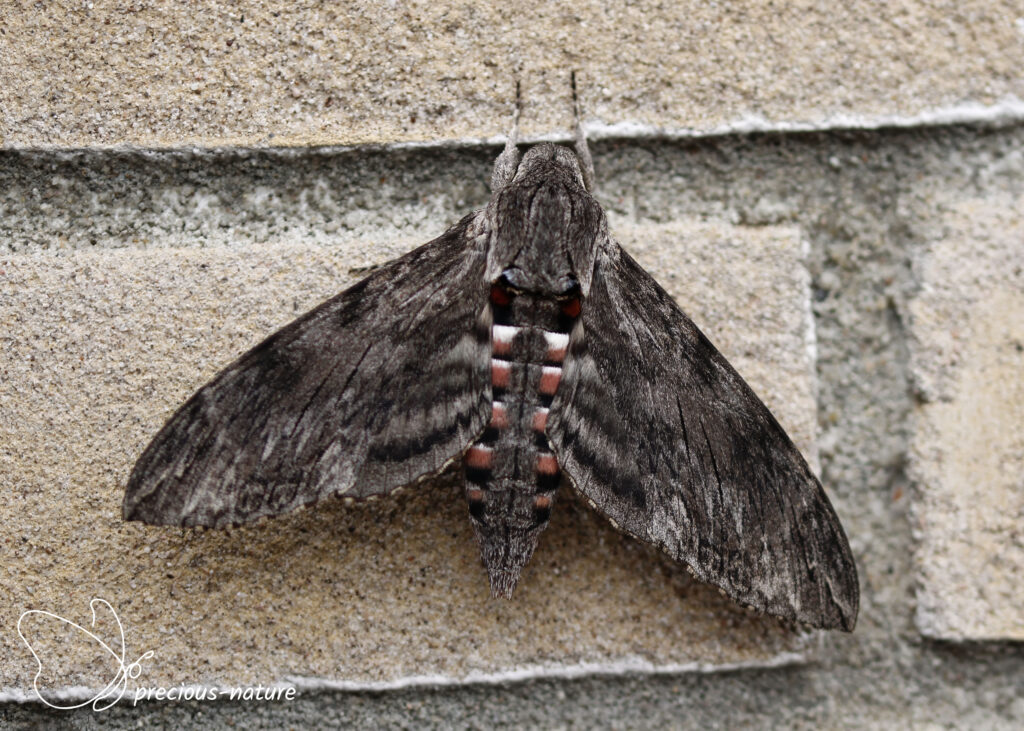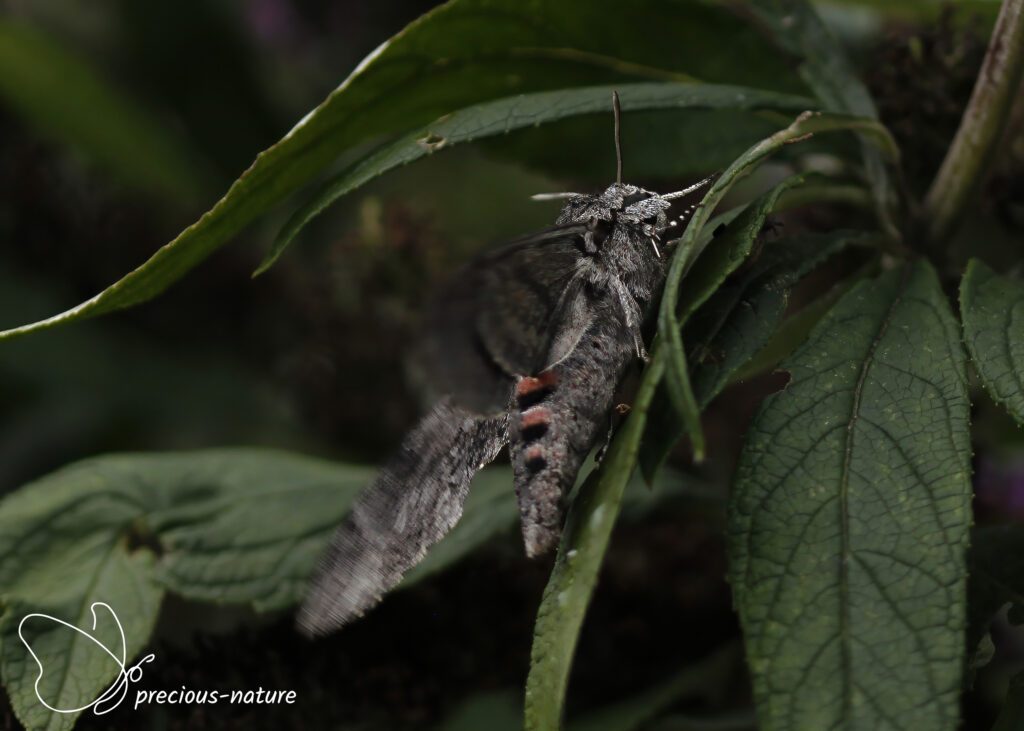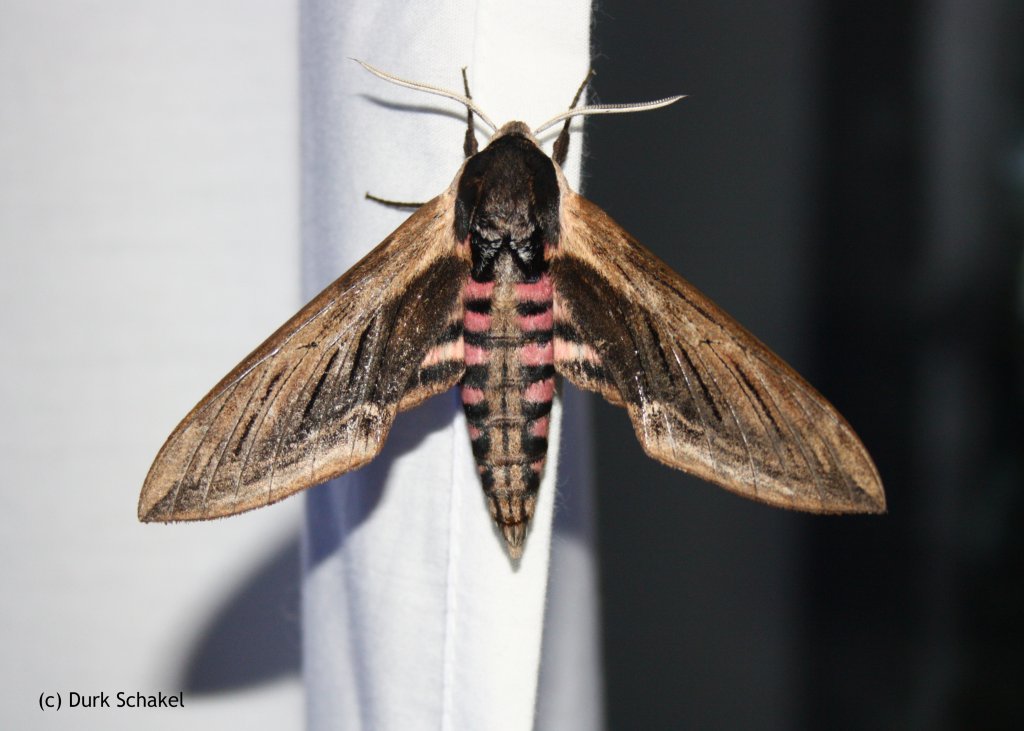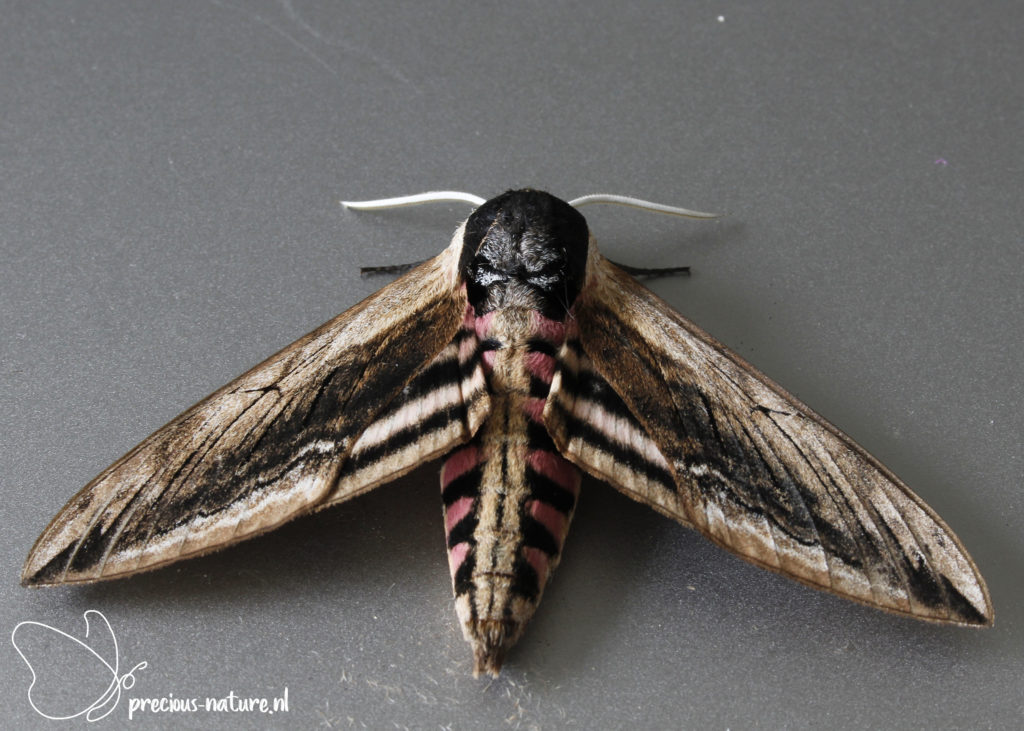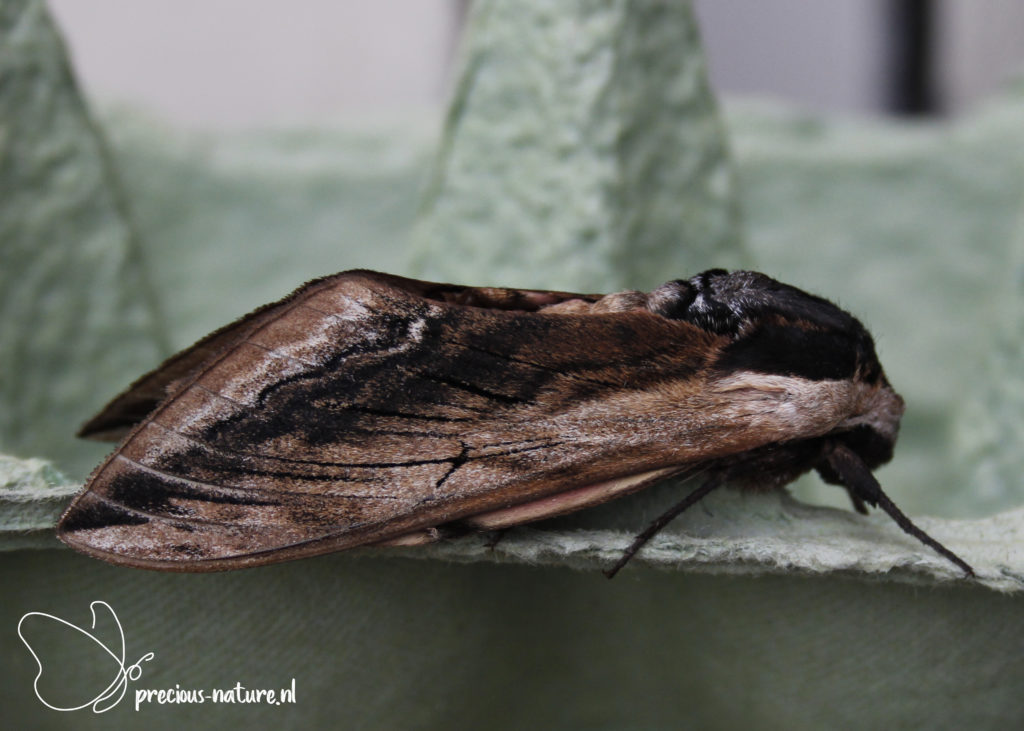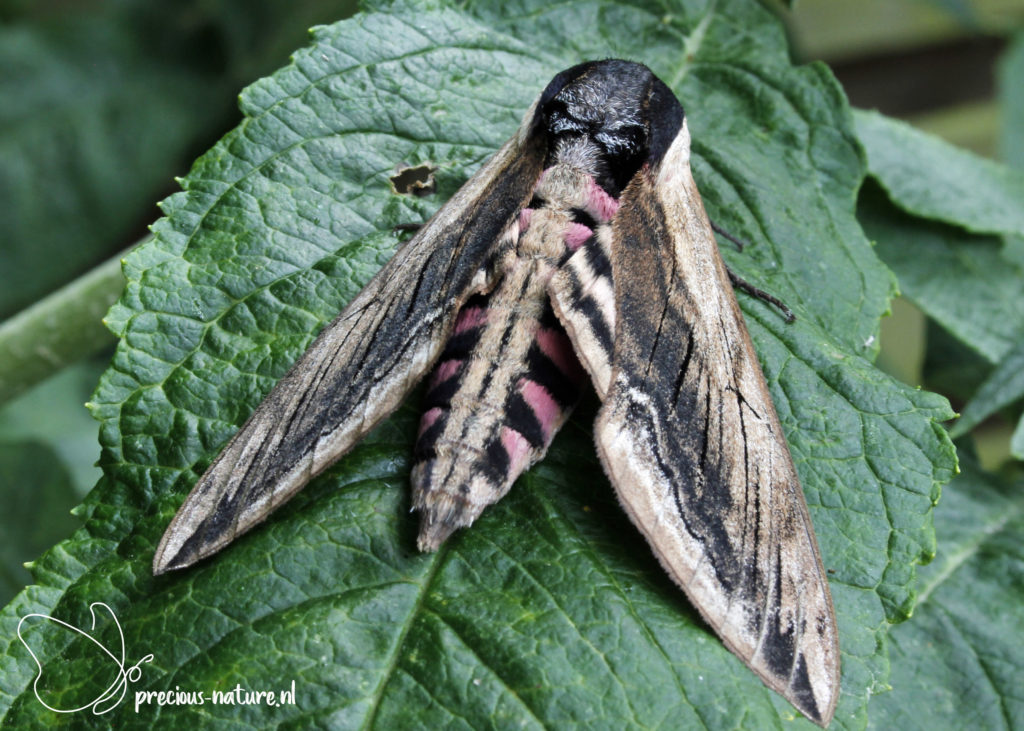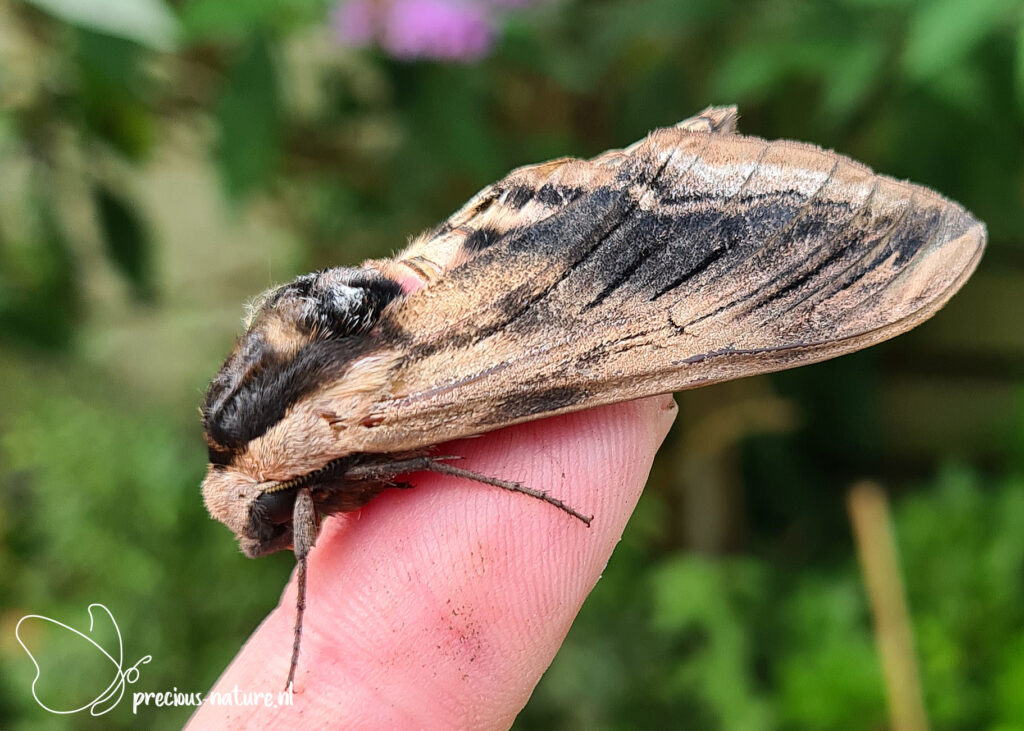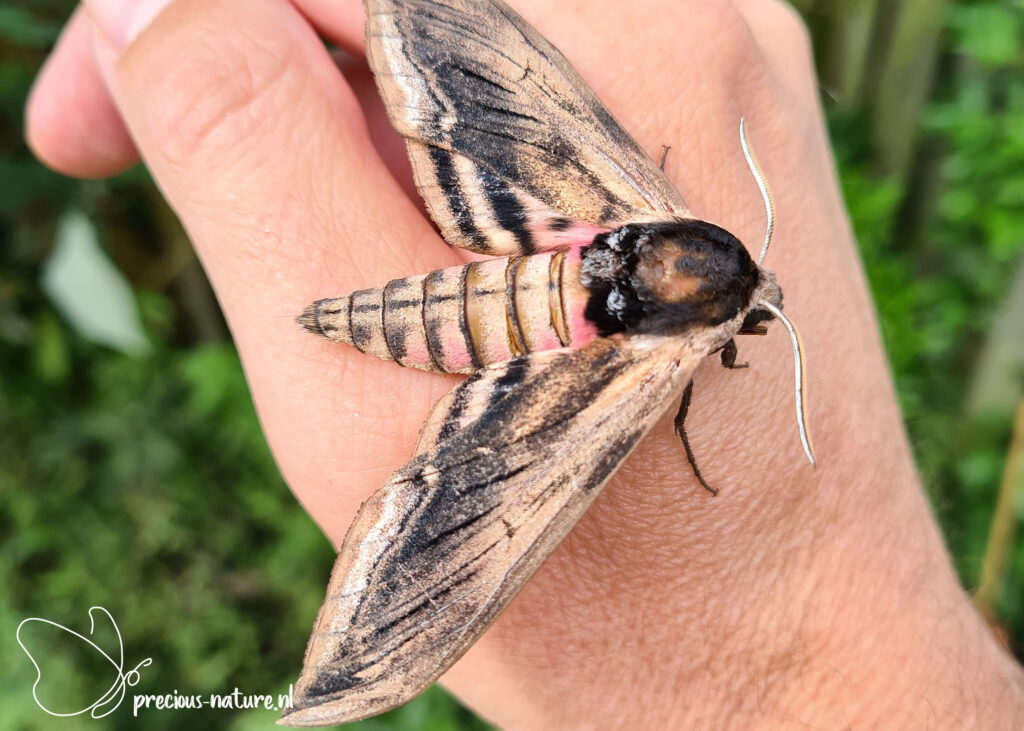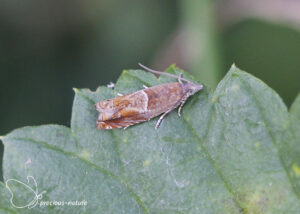The Sphinx and Hawkmoths (Sphingidae) are generally large. The smaller species usually fly during the day, and most feed much like hummingbirds, hovering in front of a flower and sipping nectar through the extended proboscis. The proboscis rolls up when not in use. The night-active species can be found resting during the day. These are often fresh copies. They have a strikingly thick body, long, narrow forewings, and are often remarkably colored. The wingspan varies from 35-150 mm. Since 2017, I have used a unique lamp and a white sheet to photograph moths. The Sphingidae are strong and fast flyers, with a rapid wingbeat. The active species get well on UVA light at night by flying around restlessly like a humming top and eventually finding peace on the sheet.
Subfamily: Macroglossinae
Tribe: Diliphonotini
Genus: Hemaris
Broad-bordered Bee Hawk-moth – 2006 (NL)
(NCBI-index: 987953)
The Broad-bordered Bee Hawk-moth (Hemaris fuciformis) resembles a bumble-bee and is a species that flies around during the day in sunny weather. You often see them flying around honeysuckle, but also Bugle, and Rhododendron. The abdomen is colored with two white spots and a reddish-brown band. They have long clubbed antennae and are much larger than the superficially similar bee flies. The wingspan is 40-48 mm. Because they hardly sit quietly, I have not been able to take a good picture of this butterfly. In addition, I rarely encounter them in the North. This hawkmoth flies around in two generations from May to August. Host plant: Wild Honeysuckle, Snowberry. Dutch name: Glasvleugelpijlstaart. Frisian name: Glêswjukpylksturt.
Flying period:

Subfamily: Macroglossinae
Tribe: Macroglossini
Genus: Deilephila
Elephant Hawk-moth – 2017 (NL)
(NCBI-index: 283834)
The Elephant Hawk-moth (Deilephila elpenor) is an easily recognisable moth. The body is olive-green with a pink broken straight line on the abdomen, like the centerline on a road, running towards the pink point tail. A pink line pattern can be seen near the head. Pink transverse stripes can also be seen on the top of the forewing. The underside of the body is colored pink. The wingspan is 43-60 mm. This butterfly flies in one generation from May to September. Host plant: Willowherb, Bedstraw, Enchanter’s Nightshade. Dutch name: Groot avondrood. Frisian name: Oaljefantsflinter.
Flying period:

Subfamily: Macroglossinae
Tribe: Macroglossini
Genus: Hyles
Spurge Hawk-moth – 2024 (CH)
(NCBI-index: 283855)
I remember first discovering the Spurge Hawk-moth (Hyles euphorbiae). In the Swiss Alps, there was warm weather during midday, and during a walk in the mountains, something large flew back and forth quickly. Barely recognisable, but the sound of the rapid wingbeat was audible. This had to be a hawk-moth that, despite being a moth, had been disturbed in its environment during the day. Then it was quiet again, and it was hidden somewhere. As soon as I got closer, it flew back and forth quickly in my environment again. Finally, I saw it sitting in the tall grass. Euphoria, so beautiful. A dull olive-green hawk-moth with a light-colored, usually pink-tinted broad stripe over the large forewing that runs diagonally from the inner edge to the wing tip. This stripe wholly or almost touches the leading edge in several places. The underside of the wings is pinkish. The flight period is one generation, sometimes a second during a warm period, from May to early September, and the wingspan is 55-75 mm. Host plant: Cypress Spurge and other spurge species. Dutch name: Wolfsmelkpijlstaart. Frisian name: Duveldrekpylksturt.
Flying period:

Subfamily: Macroglossinae
Tribe: Macroglossini
Genus: Macroglossum
Humming-bird Hawk-moth – 2015 (NL)
(NCBI-index: 524428)
The Hummingbird Hawk-moth (Macroglossum stellatarum) is very similar in behaviour to the hummingbird. He stands still in the air with his quick wing stroke before a flower to drink nectar. The primary colour of the top of the wing is brown with some dark brown transverse lines. During the flight, the orange colour of the underside of the wings is visible. The wingspan is 50-58 mm. The hummingbird butterfly flies from February to November and often during the day. Host plant: Lady’s Bedstraw, Wild Madder. Dutch name: Kolibrievlinder. Frisian name: Kolibryflinter.
Flying period:

Subfamily: Smerinthinae
Tribe: Smerenthini
Genus: Laothoe
Poplar Hawk-moth – 2017 (NL)
(NCBI-index: 522836)
The Poplar Hawk-moth (Laothoe populi) has a striking sight and flies in two generations from April to August, and the wingspan is 65-90 mm. The first time I saw this hawk-moth was in the grass during the day. This was probably a fresh specimen because this large moth does not usually occur during the day. The top of the fore- and hindwings are grey with extensive brown stains. A small white spot can be discovered on the forewing. When the butterfly rests, the hindwing protrudes past the forewing, and the abdomen is curved up. If disturbed, the moth flashes reddish-brown patches on the underwings. The thick head has grey hair. Host plant: Poplar, Willow. Dutch name: Populierenpijlstaart. Frisian name: Peppelpylksturt.
Flying period:

Subfamily: Smerinthinae
Tribe: Smerenthini
Genus: Smerinthus
Eyed Hawk-moth – 2020 (NL)
(NCBI-index: 469260)
The morning after a moth session, I removed the white sheet and a big surprise came forward. The Eyed Hawk-moth (Smerinthus ocellata) sat quietly on the canvas. This big moth owes its name to the eyespot on the pink-red hindwing. The eyespot consists of a blue stain with a black border and a black spot at its centre. The hindwings are shown to scare natural enemies as soon as it is disrupted. He then takes the opportunity to flee. The colour of the forewing can range from pinkish-brown to deep chocolate brown or even black. The contrast of the forewing is very variable and somewhat resembles the bark of a tree trunk. The wingspan is 70-80mm, and the flight period is from April to August for one generation. Host plant: Willow, Poplar, Apple. Dutch name: Pauwoogpijlstaart. Frisian name: Pau-eachpylksturt.
Flying period:

Subfamily: Sphinginae
Tribe: Acherontiini
Genus: Agrius
Convolvulus Hawk-moth – 2023 (NL)
(NCBI-index: 55055)
The first copy I spotted from the Convolvulus Hawk-moth (Agrius Convolvuli) was a real surprise. At first, I was focused on the moth trap in the early morning, but when my daughter pointed to a large specimen on the wall behind me, I was pleasantly surprised. There was a large hawk-moth with its mouse-grey base colour on the yellow stones. With the female, the streaky drawing dominates on the front wing, and the two black lines in the slightly darker brownish-tinted midfield are most striking. The male has a more marbled front wing, with a clear dark midline present. At the front edge of the wing, two sloping blackish crossbands walk halfway through the wing. The inner of it seems to be transferred through a kink into a black wipe between the two black cross lines, extending to the wing’s rear edge. This black drawing is missing the female, and the antennas are shorter and thinner. In the position of rest, the roof-shaped wings are held stiff against the body. The abdomen is pink with black stripes. The flying period is one generation from mid-May to mid-October and the wingspan is 80-120 mm. Host plant: Bindweed and Hedge Bindweed. Dutch name: Windepijlstaart. Frisian name: Klimmerpylksturt.
Flying period:

Subfamily: Sphinginae
Tribe: Sphingini
Genus: Sphinx
Privet Hawk-moth – 2017 (NL)
(NCBI-index: 470732)
The Privet Hawk-moth (Sphinx ligustri) is easily recognisable by its blackish top of the head and the dark brown stain along the forewing dorsum. The abdomen and hindwings are striped pink and black. This moth flies in one generation from May to September, flies at night, and is attracted to light. He feeds on nectar from highly scented flowers. Freshly emerged adults can sometimes be found resting vertically. The wingspan is 90-120 mm. Interestingly, the caterpillar overwinters as a pupa, 30 cm or more underground. Host plant: Privet, Lilac, Ash saplings, Snowberry, Guelder-rose, Honeysuckle. Dutch name: Ligusterpijlstaart. Frisian name: Ligusterpylksturt.
Flying period:


